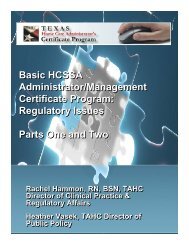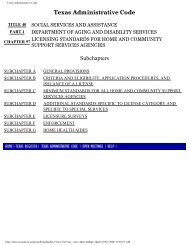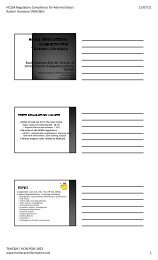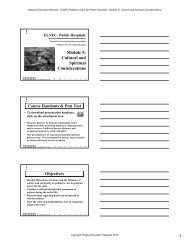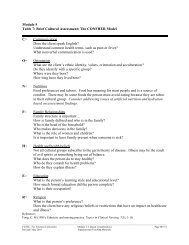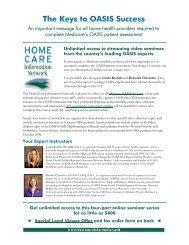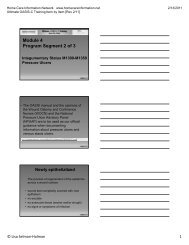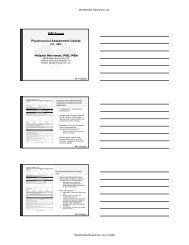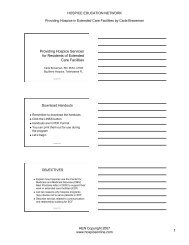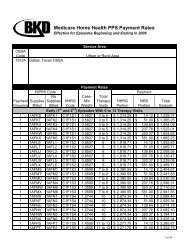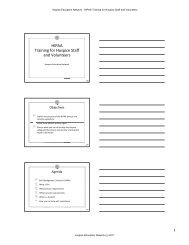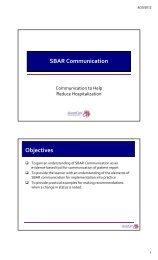Emergency Preparedness Policy and Procedure Policy Application ...
Emergency Preparedness Policy and Procedure Policy Application ...
Emergency Preparedness Policy and Procedure Policy Application ...
- No tags were found...
Create successful ePaper yourself
Turn your PDF publications into a flip-book with our unique Google optimized e-Paper software.
a) Class I - Potential to be life threatening with out care. Requires ongoing treatment to preservelife. Unable to evacuate/transport self. Unable to withst<strong>and</strong> any interruption in power supply.No readily available caregiver or caregiver unable to provide needed care. Requires transportto an acute care facility or specialized shelter situation. Examples: Ventilator dependent,LVADb) Class II - Not immediately life threatening but patient may suffer adverse effect withoutservice. Visits may be postponed for 24-48 hours with minimal adverse effect. Able towithst<strong>and</strong> up to 48 hour power interruption. Unable to transfer/transport self or notransportation available from caregiver. Examples: O2 dependent with severe COPD, Insulindependent <strong>and</strong> unable to self inject, large open draining wound with potential for sepsis, IVantibiotics.c) Class III - Low potential for adverse effect if visits are delayed 48 to 72 hours. Able to carefor self or willing <strong>and</strong> able caregiver readily available. Transportation available from family,friends, volunteers or caregiver. Examples: O2 dependent with adequate O2 supply <strong>and</strong>means to have tanks refilled. ew insulin dependent diabetic who can self inject <strong>and</strong> performglucometer checks but needs phone support or further education, tube feeding.d) Class IV - Visits may be postponed 72 hours or more with little or no adverse effects. Willing<strong>and</strong> able caregiver readily available or patient independent in most ADLs. Transportationavailable from family, friends, volunteers or caregiver. Examples: Blood pressuremonitoring, Foley catheter changes, personal care only.11. The agency will identify clients who may need evacuation assistance <strong>and</strong> maintain triage recordsin the event of an emergency in order to coordinate <strong>and</strong> communicate with the appropriateindividuals <strong>and</strong> relevant state, federal <strong>and</strong> local officials if applicable. The agency is notresponsible for physically evacuating clients.12. The agency will ensure that all staff, volunteers <strong>and</strong> contractors are trained <strong>and</strong> oriented abouttheir responsibilities in the agency’s EPRP upon hire <strong>and</strong> when the plan is revised.13. The Administrator, Supervising Nurse (if applicable) <strong>and</strong> other individuals designated by theadministrator will review the plan at least annually, <strong>and</strong> after each actual emergency response, toevaluate its effectiveness <strong>and</strong> to update the plan as needed.14. As part of the annual internal review, the agency will test the response phase of the emergencypreparedness <strong>and</strong> response plan in a planned drill if not tested during an actual emergencyresponse. A planned drill will be limited to implementation of the agency’s “CommunicationTree”.15. [XYZ Home Health Agency] will make a good faith effort to comply with the requirements of thispolicy during a disaster. If the agency is unable to comply with any of the requirements of thispolicy, the agency will document in the agency’s records attempts of staff to follow proceduresoutlined in the emergency preparedness <strong>and</strong> response plan.Texas Association for Home CareSample <strong>Emergency</strong> <strong>Preparedness</strong> <strong>and</strong> Response Plan <strong>Policy</strong>04-20083



